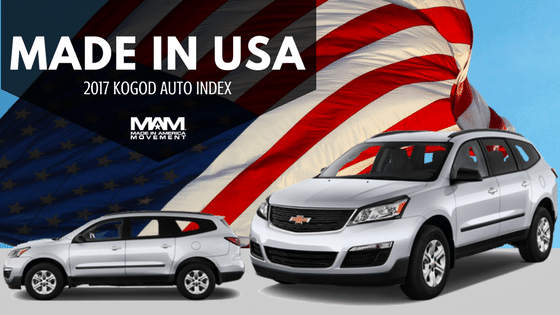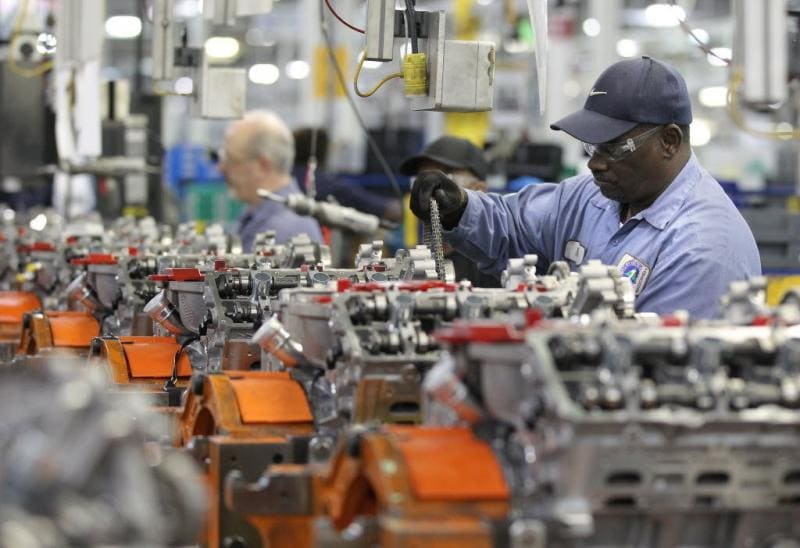Made in USA: The 2017 Most American-Made Vehicles Are…
In the United States, American-made products are highly regarded, with good reason, as they obviously boost the local economy as opposed to foreign-made products. However, are all the domestic-brand vehicles really assembled with components sourced from the United States? That’s what the Kogod School of Business figured out.
This establishment just published their 2017 Kogod Made in America Auto Index, which ranks the automotive fleet by their American content, or the percentage of the vehicles that contributes to the local economy. This report rounds up the U.S. and Canadian markets and takes into account where the engine, the transmission, the cockpit and the chassis come from, in addition to the assembly location and even where the profit margin ends up.
[clickToTweet tweet=”Of the 17.5M #autos sold in U.S. in 2016, 65% were produced in the USA via #KOGOD #automakers” quote=”‘Of the 17.5 million vehicles sold in the U.S. in 2016, approximately 65% were produced in the United States,’ according to the study. A vehicle’s ‘domestic manufacturing composition’ helps determine its impact on the U.S. economy, the study said.”]
Made in America Auto Index — 2017 Research by Frank Dubois
What percentage of your vehicle’s value contributes to the overall well-being of the U.S. economy and why does this information matter to you?
Kogod’s 2017 Made in America Auto Index seeks to answer these questions by evaluating the domestic content of vehicles sold in the US. The index takes into account other aspects of vehicle manufacturing that are not accounted for in other measures.
Why is the Index important?
Economic Impact
The manufacture and sale of automobiles is a significant component of the U.S. economy. In 2016, the auto industry directly employed approximately 2.5 million workers and generated a record 17.5 million units in total vehicle sales, accounting for approximately 3.5 percent of the U.S. GDP. This represents a slight increase over 2015 sales which was the previous record. Of the 17.5 million vehicles sold in the U.S. in 2016, approximately 65 percent were produced in the United States.
As such an important part of the U.S. economy, understanding the factors that influence the automobile industry is not just helpful—it is essential. A vehicle’s domestic manufacturing composition plays a key role in determining its overall impact on the American economy. This knowledge empowers consumers and automakers alike to make better economic decisions about where a car is made, and which offer the greatest commercial benefits to the country.
Improving Upon the Label
One of the first things a consumer looks at while car shopping is the price and options label.
Since the enactment of the American Automotive Labeling Act (AALA) in 1994, automakers are required to provide information on the label detailing the amount of U.S. and Canadian parts content, the country of assembly, and the engine and transmission’s country of origin.
AALA data, while useful, is not the most accurate means of assessing a vehicle’s contribution to the U.S. economy. It presents a number of limitations; U.S. and Canadian content are combined into one number, and automakers are allowed to round-up a part that is potentially only 70% U.S./Canadian to 100% U.S./Canadian.
Kogod’s method improves on the AALA data by incorporating a more comprehensive research methodology, providing consumers with a more accurate view of their vehicle’s composition.
How Does The Index Work?
The index uses seven points derived from publicly available data.
The components of the index are based on research into the economic value of different components of auto manufacturing that was done by the Center for Automotive Research in Ann Arbor Michigan. For example, the highest ranked cars are made by U.S. based manufacturers using American engines and transmissions, and a with a high AALA percentage of U.S. and Canadian parts.
The seven criteria are as follows:
- Profit Margin – This was measured based on the location of an automaker’s headquarters. If an automaker’s global headquarters is located in the US, the model receives a 6. If it is not, it receives a 0. The assumption here is that (on average), 6% of a vehicle’s value is profit margin, so if it is a U.S. automaker, the profits remain in the country.
- Labor – This category considers where the car is assembled. If a model is assembled in the US, it receives a 6. If not, the model receives a 0. We assume that approximately 6% of the vehicle’s value is labor content.
- Research and Development (R&D) – This category looks at the location of a car’s R&D activities. If the model is a product of a US company, it receives a 6. If it is the product of a foreign company but is assembled in the U.S. it receives a 3; if it is a foreign import it receives a 1.
- Inventory, Capital, and other expenses – If assembly occurs in the US, the model receives an 11; if not, it receives a 0.
- Engine – If the engine is produced in the US, the model receives a 14; if not it receives a 0.
- Transmission – If the transmission is produced in the US, the model receives a 7; if not it receives a 0.
- Body, Chassis, and Electrical Components – 50 % of a vehicle’s score is assigned to this category. The AALA percentage is divided into two to derive this score.
In 2014, Fiat acquired the outstanding shares of Chrysler. The new entity, Fiat Chrysler Automotive (FCA), is headquartered in the Netherlands with a tax domicile in London, and shares listed on the New York Stock Exchange. As such, because of the hybrid nature of its organizational structure and its large production and R&D presence in the U.S., we assigned a value of 3 for profit margin and R&D, rather than a 6 or 0.
The Top 10 Most American vehicles, According to Kogod
The Kogod Made in America Auto Index ranks vehicles based on how “American” they are. The study includes numerous tied rankings among the 419 entries. Here are the vehicles ranked in top 10:
1. Chevrolet Traverse
1. Buick Enclave
1. GMC Acadia
2. Ford F-150
3. Chevrolet Corvette (auto trans)
4. Jeep Wrangler Rubicon
4. Jeep Wrangler Unlimited Big Bear 4X4
4. Jeep Wrangler Limited Sport 4X4
5. Jeep Wrangler Sport 4X4
5. Ford Expedition
6. Lincoln Navigator
6. Ford Taurus
7. Cadillac ATS Sedan AWD
7. Cadillac CT6 Platinum AWD
7. Chevrolet Colorado 4WD Z71 Crew Cab
8. Jeep Cherokee
9. Honda CR-V
9. Honda Ridgeline
9. Honda Pilot
9. Acura RDX AWD/2WD
9. Kia Optima (2.0 liter)
9. Toyota Camry
10. Ford Explorer
10. Chevrolet Malibu LTD Hybrid
[clickToTweet tweet=”Highest-ranked cars made by U.S.-based manufacturers using high percentage of US + Canadian parts” quote=”‘The highest-ranked cars are made by U.S.-based manufacturers using American engines and transmissions, and (with a high) percentage of U.S. and Canadian parts,’ the study concluded.”]
View the entire 2017 Auto Index here.
According to the Kogod study, the auto industry directly employed about 2.5 million workers in 2016 and sold 17.5 million new cars and trucks.
“Of the 17.5 million vehicles sold in the U.S. in 2016, approximately 65% were produced in the United States,” according to the study. A vehicle’s “domestic manufacturing composition” helps determine its impact on the U.S. economy, the study said.
“This knowledge empowers consumers and automakers alike to make better economic decisions about where a car is made, and which offer the greatest commercial benefits to the country,” the release said.











In this era of outsourced manufacturing especially in the motor industry, it’s a pleasure to read an article about Made in USA. As an American, it gives me great pleasure to know that I am supporting local businesses. As I look to purchase my first car, this Auto Index will no doubt provide influential insights to the brand and model of car I am going to get.
Hi! I am so glad to read this helpful article about american vehicles. Recently I bought one of them.